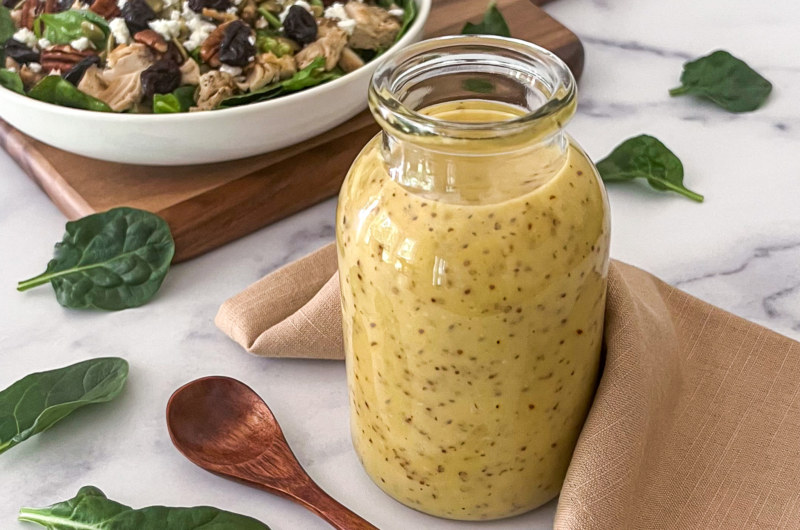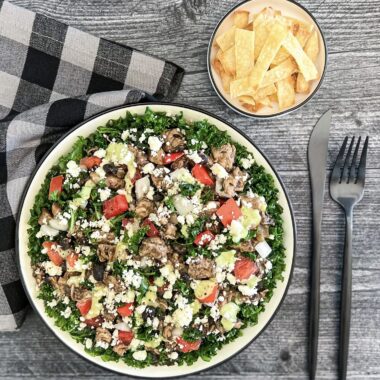If you ask me what’s the single most important key to a good salad, without any hesitation, I will tell you the dressing. Probably not what you expected, huh? But for me, it is! In addition to enhancing the flavor and overall texture of salads, dressing can actually help your body better absorb certain vitamins and antioxidants housed in the veggie and fruit layers you eat.
However, I’d be remiss if I didn’t point out that salad dressings aren’t all created equal. Many store-bought varieties on the market are made with subpar ingredients. Since most are shelf-stable, they also tend to pack in lots of sugar, sodium and preservatives. This is why I always encourage people to build their bowl with homemade salad dressing whenever possible.
While making your own dressing might seem a bit intimidating, it’s really quite simple. In fact, with just a handful of ingredients, you can make good quality dressing that tastes even better than store-bought versions and most restaurants. Here, I’ll tell you exactly what you need to make healthy, smackin’ good salad dressings in the comfort of your own home.
Spoiler alert: It all starts with fat.
Embrace all the goodness of fat.

As I’ve already mentioned, dressing can help your body better absorb certain vitamins and antioxidants housed in the veggie and fruit layers of a salad. But I haven’t mentioned that this is all owed to the fat that makes up a good dressing. Without that fat, your body can’t adequately absorb these nutrients. Needless to say, using a fat-free salad dressing would actually defeat the purpose of eating a salad in the first place.
Now, that I’ve cleared that up, let me also clarify that the type of fat you use does matter. All fat is not good fat. This is where many store-bought salad dressings fall short. When it comes to choosing fat for a homemade salad dressing, you want to go for one that’s naturally rich in monounsaturated and polyunsaturated fatty acids. I’ve previously written a blog highlighting all the ins and outs of these and other types of fat so be sure to give it a read.
Some of my personal favorite fats to use for salad dressings include extra-virgin olive oil, grapeseed oil, avocado oil, avocado oil-based mayonnaise and full-fat Greek-style yogurt. Check out our Honey Mustard Dressing recipe to see how these layers can come together. If your diet is oil free, avocado, nuts and seeds are great options too! Our Vegan Blue Cheese Dressing is a flavorful blend of cashews and other oil-free layers.
Add a burst of acidity.

Though I’ve emphasized the importance of fat for good flavor and nutrient absorption, acids are actually what makes dressing taste like “dressing.” Besides all the bright and tangy notes acids bring to different blends, they add rich depths of flavor too. Vinegars are among the most versatile acids for salad making but acidic fruits like lemon and lime work too. And it just so happens that acids and fat go together like peas and carrots.
Here at That Salad Lady, we create salad dressing recipes with all types of vinegar including balsamic, wine, champagne, rice and apple cider vinegars in addition to citrus fruits. These acids all come with their own unique benefits. Vinegars, for instance, contain essential nutrients that support good digestion and food metabolism while citrus fruits are rich in health-promoting flavonoids and vitamin C, both of which function as powerful antioxidants.
What’s nice is that once you have an acid and a fat, you’ve got yourself the main layers for a good homemade salad dressing. If you choose to mix an oil and an acid, you can build a simple vinaigrette like our Refreshing Champagne Vinaigrette Dressing. For a creamier mouthfeel, you might blend an acid with mayonnaise, avocado or chickpeas. Check out our Creamy Balsamic Vinaigrette Dressing, which is built with dairy-free yogurt.
Bring the tangy and sweet.

To bring even more flavor and good nutrition to your homemade salad dressing, don’t be afraid to experiment with different tangy and sweet layers. Some great options include whole grain and Dijon mustards, tart berries and tomato for tang in addition to pure honey, maple syrup and fruits like apple and orange for the sweet.
Besides being excellent flavor enhancers, these types of layers are valuable sources of disease-fighting micronutrients too. Since you’ll generally add them in small amounts, they won’t necessarily lead to significant improvements in your health, but at the very least, these layers will contribute to your daily tally. Every little bit counts!
We use many tangy and sweet layers in our salad bowl and dressing recipes here at ThatSaladLady.com. Our Raspberry Walnut Vinaigrette Dressing is one of my personal favorites. It’s a fresh, fruity and delightfully rich combination of fresh raspberries and raspberry preserves that’s perfect for spring and summer bowls.
Build bold flavor with herbs and spices.

Regardless of the fat and acid combination you choose, it’s the flavor enhancers that’ll ultimately transform your homemade salad dressing from basic to downright craveable. Herbs and spices are by far the easiest and most nutritious way to bring bold flavor to salad dressings, whether fresh or dried. You can start with simple ones like oregano, parsley, rosemary, basil and thyme. Having a good spice rack will give you even more options on hand.
Our Restaurant Style Ranch Dressing includes an exquisite mixture of dried herbs and spices including parsley, dill, chives, onion powder and garlic powder. If you’re a fan of ranch, it is indeed a must try!
At a minimum, I always suggest using either a fresh or dried form of garlic. Hardly any of my salad dressings are built without it. With its savory, aromatic qualities, garlic can bring practically any dressing to life. As both an allium vegetable and an herb, garlic contains many unique phytonutrients that boast powerful antibacterial, antioxidant and anti-inflammatory effects (study up in our Nutrition Glossary to learn more).
Think outside the box more.

Let me emphasize that you don’t really need a recipe to build a good homemade salad dressing – all you need is good layers. Here at That Salad Lady, we want you to experience a new eagerness to try new things. That’s one of our “Guiding Principles.” While you may have to step outside of your comfort zone a bit, adding just one or two of the layers I’ve talked about can transform a simple blend of fat and acid into an utter explosion of flavor.
Think about the tastes and textures that are generally most enjoyable for you and your family and see if you can create a salad dressing to suit them. I’ve included everything from onions, cheeses, nutritional yeast, ketchup, hot sauce and even nut butters in different types of dressing. There’s no harm in trying something new. The worst-case scenario is that you don’t like a particular blend, but you never know until you try.
Our Easy Thousand Island Dressing recipe is the perfect example of thinking outside the box, as it includes clever layers like ketchup, mayonnaise and even relish.
Start putting dressing making into practice.

I know I threw a lot of information at you – I promise it’ll all click once you begin to gather some of the layers I’ve talked about here, free your mind and actually start building your own salad dressings at home. Don’t know where to begin? Creative juices not flowing? No sweat! Here are a few simple dressings you can put together as a start.
Maple Dijon Vinaigrette Dressing
- 1/2 cup extra-virgin olive oil
- 1/4 cup apple cider vinegar or lemon juice
- 1/4 cup grainy or creamy Dijon mustard
- 2 tablespoons pure maple syrup or honey
- 2 garlic cloves, minced
- 1 teaspoon dried oregano, parsley or basil
- Freshly ground black pepper, to taste
- Kosher or sea salt, to taste
Rich and Tangy Catalina-Style Dressing
- 1/2 cup grapeseed oil
- 1/3 cup unsweetened ketchup
- 1/4 cup red wine vinegar
- 1/4 cup pure honey or maple syrup
- 1 tablespoon tomato paste
- 1 teaspoon Worcestershire sauce
- 1 teaspoon liquid aminos or soy sauce
- 1 teaspoon onion powder
- 1 teaspoon garlic powder
- 1/2-1 teaspoon sweet paprika
Oil-Free Avocado Dijon Dressing
- 1 ripe avocado
- 1-2 tablespoons grainy or creamy Dijon mustard
- 1-2 tablespoons freshly squeezed lime juice
- 3-4 tablespoons filtered water, more if needed
- 1 garlic clove, minced
- 1-2 tablespoons pure honey or maple syrup (optional)
- 1/4-1/2 cup fresh parsley
- Freshly ground black pepper, to taste
- Kosher or sea salt, to taste

Once you’ve gathered all the ingredients for whatever homemade salad dressing you plan to make, the hard work is pretty much done. Simply mix the ingredients to your desired consistency. You can do this with either a blender or a food processor. With variable speed units, start with a low speed and then gradually increase it to a higher speed until your dressing is perfectly smooth.

If you don’t have a blender or a food processor, just add all the ingredients to a jar with a twist off lid and shake it up until everything’s well-mixed. You can also combine and whisk all your ingredients together in a bowl. It’s as simple as that!
One more thing! If you choose to make an oil-free dressing at home, be sure to build your bowl with some good fat in the form of avocado, nuts, seeds or even oily fish like salmon, trout or tuna. Each of these layers supply good amounts of monounsaturated and/or polyunsaturated fats. Remember, you’ll need these fats for adequate nutrient absorption.







Just tripped across your website and am SO excited to find you! I’ve been making a lemon vinaigrette for years, using fresh lemon juice and olive oil as the base, plus dijon mustard and plenty of garlic + herbs/spices. Homemade dressing takes a salad to the next level!
Awesome Sybil and welcome! Totally agree. Homemade dressing is a game changer 😊
I am so glad I found you! I love salads
Awesome Debbie and welcome 😊
I so glad that I found you too. I’m so excited about these salads and salad dressings, I’ve always wanted to make my own salad dressings but didn’t know how, Thank you so much,
Awww, you are most welcome Brenda and so very happy you’re here! Once you start building your own batches of homemade salad dressing you’ll never be the same 😊
Great post! Thanks! I’ve never thought to make a dressing with just avocado for the fat before. I’m definitely going to give that a try.
Hi Holly and thank you so very much. The avocado dressing is definitely a game changer 😊